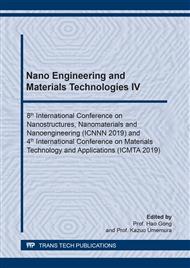p.204
p.209
p.215
p.220
p.225
p.231
p.239
p.244
p.250
Eco-Friendly Preparation of Nanofibrillated Cellulose from Water Hyacinth Using NaOH/Urea Pretreatment
Abstract:
In this work, we described an effective approach to prepare nanofibrillated cellulose (NFC) with cellulose II structure under mild condition. Firstly, the water hyacinth (WH) was subjected to a series of a two-step chemical treatment, NaOH/urea pretreatment, and mechanical defibrillation at different defibrillation times. After that, raw water hyacinth fiber (RWF), bleached water hyacinth fiber (BWF), NaOH/urea pretreated water hyacinth fiber (PWF), and the resulting NFC were characterized by scanning electron microscopy (SEM), transmission electron microscopy (TEM), thermogravimetric analysis (TGA), Fourier transform infrared spectroscopy (FTIR), X-ray diffractometry (XRD) as well as rheological measurements. It was found that RWF and BWF exhibited cellulose I crystal structure, whereas PWF and the obtained NFC possessed cellulose II crystal structure. FTIR analysis confirmed the evidence that no other chemical reactions preferentially occurred during both NaOH/urea pretreatment and mechanical defibrillation. As evidenced by rheological properties analysis, the NFC aqueous suspension with a gel-like structure demonstrated a shear-thinning behavior. The obtained NFC could potentially be utilized as a reinforcement for polymeric composites.
Info:
Periodical:
Pages:
225-230
Citation:
Online since:
May 2020
Authors:
Price:
Сopyright:
© 2020 Trans Tech Publications Ltd. All Rights Reserved
Share:
Citation:


